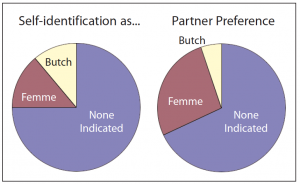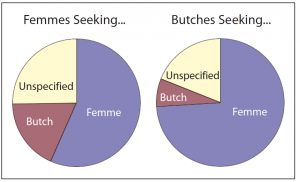‘BUTCH” AND “FEMME” roles have been part of lesbian culture since the 19th century and are said to be undergoing a resurgence in the American lesbian community. But just how central are these roles when lesbians actively seek one another out for a possible relationship? One vehicle that lesbians (and others) use in this pursuit is the personal ad, typically placed in an urban gay and lesbian newspaper, a format that enables the person placing the ad to describe both her own qualities and those to which she’s attracted in someone else. In a study, we assumed that the importance of butch and femme roles for lesbians seeking a relationship would be reflected in the content of these ads.
To say that there’s a “resurgence” in the popularity of butch and femme roles is to suggest that these roles have waxed and waned over time, and this does appear to be the case. Although butch-femme roles have been around for a long time, the degree to which they’ve been accepted within the lesbian community has varied greatly from one era to the next. Butch and femme styles were prevalent among poor and working-class lesbians in the early 20th century, but by the 1950’s these roles began to be rejected by middle-class lesbians, who favored “a mode of behavior and dress acceptable to society,” in the words of the Daughters of Bilitis Newsletter, published from 1957 to ’67.
In the 1970’s, during the second wave of the feminist movement, these roles continued to remain out of favor, particularly among middle-class lesbians, who preferred a more androgynous appearance and style. Butch and femme roles resurfaced in the 1980’s and 90’s, primarily among young, urban, middle- and upper-class lesbians. However, new combinations of butch-butch and femme-femme couples have also been observed in the past two decades.
In our study, we sought to determine what proportion of lesbians identified themselves as butch or femme when looking for partners through personal ads, and what proportion specified that they were seeking a butch-femme pairing. Personal ads were taken from “alternative” newspapers from around the United States as well as one Internet site (Qworld.com). Sixteen newspapers were selected from across the U.S. to achieve a roughly representative sample. At least two issues of each newspaper were included in our survey. A total of 388 ads were examined from the “Women seeking women” section of the papers and the website. All of the ads in this category were included for each of the sources in our sample. However, advertisers who were seeking exclusively sexual partners were excluded, as were advertisers who identified as bisexual. The racial breakdown of advertisers was as follows:
No race specified 56 percent
African-American 22
White 18
Hispanic 3
Asian-American 1
Each ad was coded for the presence or absence of butch or femme descriptors both in the advertiser’s self-identification and in the type of partner she sought. Terms such as “soft butch,” “stone butch,” and “masculine” were coded as butch labels. Femme labels included “ultra fem,” “high femme,” “lipstick lesbian,” among others.
What we found is that the vast majority of the lesbians who placed these ads—fully 75 percent—did not self-identify as either butch or femme. Of the remaining quarter, some fourteen percent identified themselves as femme compared to eleven percent who described themselves as butch.
The following ads are typical of those that did not use butch or femme descriptors:
Looking for fun. I’m 28yo, honest, respectful and considerate. Would love to find a similar woman to go out to dinner with, movies and long walks on the beach. Must be an animal lover.
Complex girl seeks same. Girl, 22, into indie rock, writing & Pop Culture, seeks quirky, sexy, emotional girl to love & comfort me. I’m a fat curly-haired feminist. UB charming & open minded.
GBF, professional, intelligent, attractive, seeking GF 39–49. Interests: sports, travel, museum & music. Friendship & possible LTR.
A somewhat larger proportion of the women—about two-thirds—specified their preference for a butch or femme partner in their ads, but a substantial majority (66 percent) were silent on this matter. When labels were specified, many more women—fully 26 percent—were seeking a femme partner, compared to only five percent who sought a butch. In fact, twelve ads (three percent) explicitly included a request for “no butches.”
 This finding already begins to suggest an asymmetry between butch and femme women as targets of desire, throwing into question the stereotype that lesbian relations in general are built upon a butch-femme pairing. In our study, in fact, self-identified femmes were far more likely to request another femme as their partner than to request a butch type, at 56 percent versus 18 percent (with another 25 percent expressing no preference). In addition, thirty-seven advertisers who did not identify as butch or femme specifically requested femme partners.
This finding already begins to suggest an asymmetry between butch and femme women as targets of desire, throwing into question the stereotype that lesbian relations in general are built upon a butch-femme pairing. In our study, in fact, self-identified femmes were far more likely to request another femme as their partner than to request a butch type, at 56 percent versus 18 percent (with another 25 percent expressing no preference). In addition, thirty-seven advertisers who did not identify as butch or femme specifically requested femme partners.
Here are a few representative ads of those that indicated a preference for a femme partner:
Gay white female wants you if you are feminine, free, caring, kind, and loving. Let’s get together for fun and laughs and ?? No drinkers/drugs.
Feminine seeking feminine professional, GBF, mid 30’s, 125 lbs., looking for another woman for friendship, and possibly more. Please no butches or heavy women. I enjoy movies, travel, reading, eating out, and cultural events.
SGWF seeks SBi/GF, feminine, 28–35, for friendship and more. Must like children. Light smoker. Drug/disease free. Must be honest, serious, and responsible.
What’s more—though perhaps less surprisingly—women who self-identified as butch lesbians were much more likely to request a femme partner than a butch partner, at 74 percent versus only 7 percent (with 19 percent not indicating).* Additionally, eight advertisers who did not specify any descriptors for themselves sought butch partners.
The following ads are typical of those from women who identified as butch or sought butch partners:
Attractive GF, soft butch, black hair/eyes. Educated, down-to-earth, financially stable, sensitive, loving and caring. Seeking GW/HF, 25–40, who’s professional, very feminine, and bright to do things with: dinner, movies, etc.
Serious and sincere SGWF. 45, down-to-earth, romantic, soft butch, not big on bars but likes to dance, smoker but hope to quit. Looking for age 30-49. Weight proportionate, personality and chemistry a plus.
Wanted butch. GWF, 5’3”, 135. Dark hair/hazel eyes, romantic. Seeking GW/Latina F 36-40 something butch who enjoys dinners/walks on the beach/movies & quiet nights.
GWF, 30, soft butch, seeks GWF, 32-40, butch, into art, movies, dancing and having a good time. No smokers, Bis, or men.
The notion that butch-femme roles are enjoying a resurgence of popularity was not supported by the results of our research on lesbians’ personal advertisements. In fact, reference to these roles appeared to be relatively unpopular among women seeking women. Perhaps most surprising was the very small number of women who specified that they were seeking a butch lesbian as a partner.
 The explanation for this finding, somewhat paradoxically, may be related to the higher visibility of butches compared to femmes. Since butch women are more likely to be perceived as lesbian, those who are seeking butches may have an easier time finding them. Individuals seeking femme partners may be more likely to use personal ads for the simple reason that it’s harder to spot femmes out in public (as in the oft-heard question, “Is she a femme lesbian or a straight woman?”). If this is the case, butch women are not necessarily less desirable, but instead easier to find without a personal ad.
The explanation for this finding, somewhat paradoxically, may be related to the higher visibility of butches compared to femmes. Since butch women are more likely to be perceived as lesbian, those who are seeking butches may have an easier time finding them. Individuals seeking femme partners may be more likely to use personal ads for the simple reason that it’s harder to spot femmes out in public (as in the oft-heard question, “Is she a femme lesbian or a straight woman?”). If this is the case, butch women are not necessarily less desirable, but instead easier to find without a personal ad.
Self-identification as femme was more common among the minority of advertisers who used butch/femme labels to describe themselves. Similarly, the minority of advertisers who had butch/femme partner preferences was more likely to seek femme partners. These results have two main implications. First, they support previous research indicating that many lesbians desire feminine qualities in their partners. Second, they suggest that lesbians do not necessarily adhere to the stereotypical butch-femme pairing. This finding is consistent with earlier research indicating that the majority of lesbian relationships do not conform to the stereotype of the butch-femme couple.
Other factors can also help to explain our findings. For one thing, the lack of butch-femme descriptors in this study may reflect a class bias. Most of the ads came from alternative papers in major cities. Readers are presumed to be relatively young, educated, and middle-class compared to the lesbian population as a whole. Thus if the butch-femme system has been associated primarily with working-class lesbians, our findings may underestimate the popularity of this type of pairing in the larger lesbian community. But there’s also a more sociologically interesting explanation for our findings. The fact that more women self-identified as femme, while many more expressed a preference for a femme partner, could suggest that a large number of lesbians embrace the norm of femininity for women that’s promoted by mainstream society.
While our research does not support the notion that butch and femme roles are undergoing a major resurgence, it does indicate that butch and femme roles have not disappeared, and indeed that they remain salient for a substantial segment of American lesbians.
* An earlier survey of lesbian identity also showed that butch lesbians tend to prefer femme partners. J. Loulan reported that about fifty percent of butch lesbians indicated a preference for femme partners, whereas 25 percent preferred butch partners and 25 percent indicated no preference (The Lesbian Erotic Dance: Butch, femme, androgyny and other rhythms. Spinsters Ink, 1990).
Christine A. Smith is assistant professor of psychology at Minnesota State University. Trained as a social psychologist, her current research interests are collective self-esteem and gender self-presentation. Shannon Stillman is a recent graduate of Lewis & Clark College.
This piece was excerpted and adapted from an article that originally appeared in Journal of Lesbian Studies, Vol. 6, No. 1, 2002 (Harrington Park Press).







Discussion1 Comment
I date Butch lesbian or trans men only no other demo. Im as femme as they come. Irs what I’m attracted to. Ev1 diff.